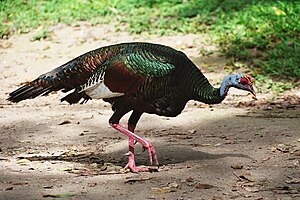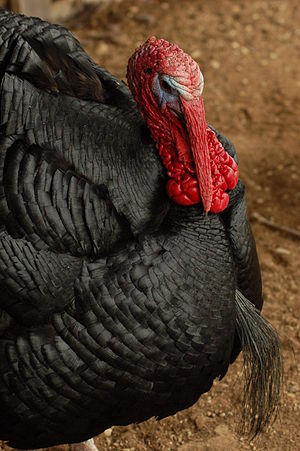Translations:AY Honors/Poultry/Answer Key/17/en
Modern turkey breeds
Broad Breasted White turkey
The Broad Breasted White is commercially the most widely used breed of domesticated turkey. These birds have shorter breast bones and larger breasts, sometimes rendering them unable to breed without human assistance (typically via artificial insemination). They produce more breast meat and their pin feathers are less visible when the carcass is dressed due to their white color. These properties have made the breed popular in commercial turkey production.
These birds are grown in large, fully automated grow-out barns, which may house as many as 10,000 birds. The growing process for these birds has been so well refined, the birds often grow to larger than 50 lbs. Average birds are typically 38-40 lbs. Because of their size, they are prone to health problems associated with being overweight (due to excess muscle), such as heart disease, respiratory failure and joint damage; even if such turkeys are spared from slaughter, they usually have short lives as a result.
Ocellated turkey
The Ocellated turkey is a domestic relative of the wild turkey (Meleagris gallopavo). The ocellated turkey lives only in a 130,000 km2 (50,000 sq mi) range in the Yucatán Peninsula in Mexico—which includes all or part the states of Quintana Roo, Campeche, Yucatán, Tabasco, and Chiapas—as well as the northern parts of Belize and Guatemala.
The body feathers of both sexes are a mixture of bronze and green iridescent color. Although females can be duller with more green, the breast feathers do not generally differ and can not be used to determine sex. Neither sex possesses the beard typically found in wild turkeys. Tail feathers of both sexes are bluish-grey with an eye-shaped, blue-bronze spot near the end with a bright gold tip. The spots, or ocelli (located on the tail), for which the ocellated turkey is named, have been likened to the patterning typically found on peafowl. The upper, major secondary wing coverts are rich iridescent copper. The primary and secondary wing feathers have similar barring to that of North American turkeys, but the secondaries have more white, especially around the edges.
Both sexes have blue heads with some orange or red nodules, which are more pronounced on males. The males also have a fleshy blue crown covered with nodules, similar to those on the neck, behind the snood. During breeding season this crown swells up and becomes brighter and more pronounced in its yellow-orange color. The eye is surrounded by a ring of bright red skin, which is most visible on males during breeding season. The legs are deep red and are shorter and thinner than on North American turkeys. Males over one year old have spurs on the legs that average 4 cm (1.6 in), which lengths of over 6 cm (2.4 in) being recorded. These spurs are much longer and thinner than on North American turkeys.
Ocellated turkeys are much smaller than any of the subspecies of North American wild turkey, with adult hens weighing about 4 kg (8.8 lb) before laying eggs and 3 kg (6–7 pounds) the rest of the year, and adult males weighing about 5–6 kg (11–13 lb) during breeding season.
Black turkey
The Black, sometimes referred to as the Black Spanish or the Norfolk Black, is a breed of domestic turkey. The Black was developed in Europe from the Aztec turkeys originally brought from Mexico by Spanish explorers. Despite the monikers of “Spanish and “Norfolk” (England), birds of this type live in many European nations. Originally, black colored turkeys were a relative rarity among New World flocks, but Europeans heavily selected for this trait until it became predominant. The "Norfolk Black" is generally considered the oldest turkey breed in the UK
Black turkeys were sent in the holds of ships on the transatlantic crossing from Europe to the New World, and were raised by early colonists. Ironically, it is likely that the turkey consumed at the first Thanksgiving meal may have actually been from European birds, rather than wild turkeys native to the continent.
Later, Blacks were crossed with the wild turkey to help produce breeds such as the Bronze, Narragansett, and Slate. They remained a commercially farmed variety in the U.S. until the early 20th century, but fell out of favor after the development of the Broad Breasted Bronze and Broad Breasted White. Fairly common in Europe, they are considered an endangered variety of heritage turkey today by the American Livestock Breeds Conservancy.


